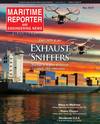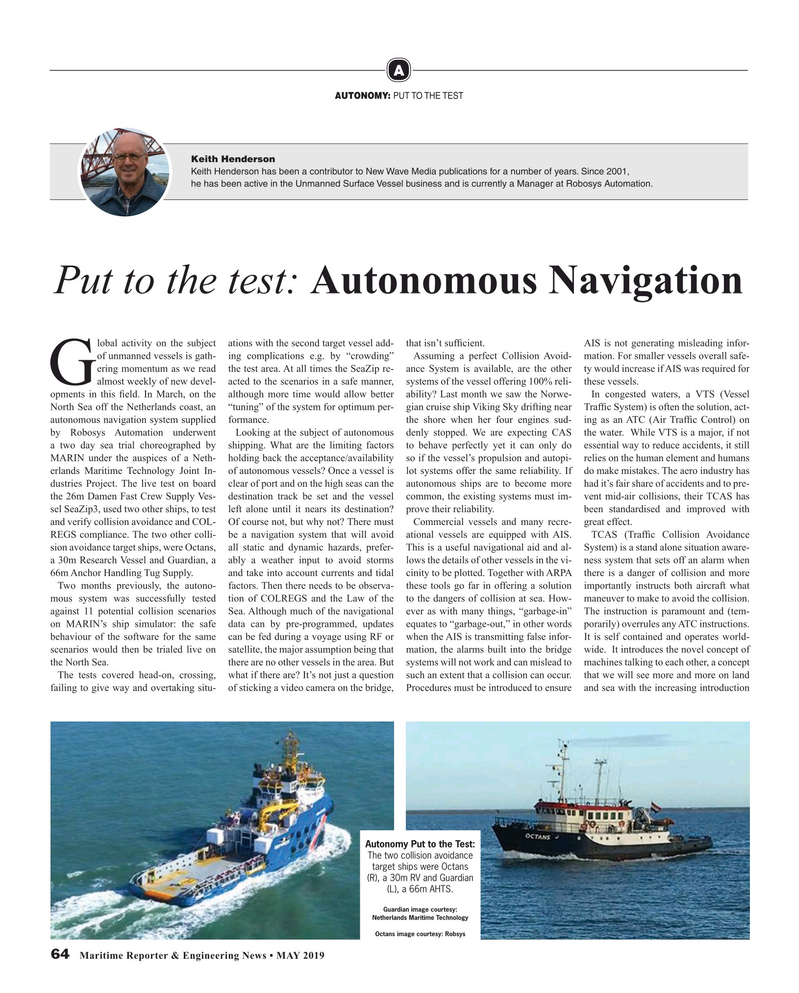
Page 64: of Maritime Reporter Magazine (May 2019)
Propulsion Annual - Green Marine Tech
Read this page in Pdf, Flash or Html5 edition of May 2019 Maritime Reporter Magazine
A
AUTONOMY: PUT TO THE TEST
Keith Henderson
Keith Henderson has been a contributor to New Wave Media publications for a number of years. Since 2001, he has been active in the Unmanned Surface Vessel business and is currently a Manager at Robosys Automation.
Put to the test: Autonomous Navigation lobal activity on the subject ations with the second target vessel add- that isn’t suf? cient. AIS is not generating misleading infor- of unmanned vessels is gath- ing complications e.g. by “crowding” Assuming a perfect Collision Avoid- mation. For smaller vessels overall safe- ering momentum as we read the test area. At all times the SeaZip re- ance System is available, are the other ty would increase if AIS was required for almost weekly of new devel- acted to the scenarios in a safe manner, systems of the vessel offering 100% reli- these vessels.
G opments in this ? eld. In March, on the although more time would allow better ability? Last month we saw the Norwe- In congested waters, a VTS (Vessel
North Sea off the Netherlands coast, an “tuning” of the system for optimum per- gian cruise ship Viking Sky drifting near Traf? c System) is often the solution, act- autonomous navigation system supplied formance. the shore when her four engines sud- ing as an ATC (Air Traf? c Control) on by Robosys Automation underwent Looking at the subject of autonomous denly stopped. We are expecting CAS the water. While VTS is a major, if not a two day sea trial choreographed by shipping. What are the limiting factors to behave perfectly yet it can only do essential way to reduce accidents, it still
MARIN under the auspices of a Neth- holding back the acceptance/availability so if the vessel’s propulsion and autopi- relies on the human element and humans erlands Maritime Technology Joint In- of autonomous vessels? Once a vessel is lot systems offer the same reliability. If do make mistakes. The aero industry has dustries Project. The live test on board clear of port and on the high seas can the autonomous ships are to become more had it’s fair share of accidents and to pre- the 26m Damen Fast Crew Supply Ves- destination track be set and the vessel common, the existing systems must im- vent mid-air collisions, their TCAS has sel SeaZip3, used two other ships, to test left alone until it nears its destination? prove their reliability. been standardised and improved with and verify collision avoidance and COL- Of course not, but why not? There must Commercial vessels and many recre- great effect.
REGS compliance. The two other colli- be a navigation system that will avoid ational vessels are equipped with AIS. TCAS (Traf? c Collision Avoidance sion avoidance target ships, were Octans, all static and dynamic hazards, prefer- This is a useful navigational aid and al- System) is a stand alone situation aware- a 30m Research Vessel and Guardian, a ably a weather input to avoid storms lows the details of other vessels in the vi- ness system that sets off an alarm when 66m Anchor Handling Tug Supply. and take into account currents and tidal cinity to be plotted. Together with ARPA there is a danger of collision and more
Two months previously, the autono- factors. Then there needs to be observa- these tools go far in offering a solution importantly instructs both aircraft what mous system was successfully tested tion of COLREGS and the Law of the to the dangers of collision at sea. How- maneuver to make to avoid the collision. against 11 potential collision scenarios Sea. Although much of the navigational ever as with many things, “garbage-in” The instruction is paramount and (tem- on MARIN’s ship simulator: the safe data can by pre-programmed, updates equates to “garbage-out,” in other words porarily) overrules any ATC instructions. behaviour of the software for the same can be fed during a voyage using RF or when the AIS is transmitting false infor- It is self contained and operates world- scenarios would then be trialed live on satellite, the major assumption being that mation, the alarms built into the bridge wide. It introduces the novel concept of the North Sea. there are no other vessels in the area. But systems will not work and can mislead to machines talking to each other, a concept
The tests covered head-on, crossing, what if there are? It’s not just a question such an extent that a collision can occur. that we will see more and more on land failing to give way and overtaking situ- of sticking a video camera on the bridge, Procedures must be introduced to ensure and sea with the increasing introduction
Autonomy Put to the Test:
The two collision avoidance target ships were Octans (R), a 30m RV and Guardian (L), a 66m AHTS.
Guardian image courtesy:
Netherlands Maritime Technology
Octans image courtesy: Robsys 64 Maritime Reporter & Engineering News • MAY 2019
MR #5 (58-65).indd 64 5/3/2019 12:36:55 PM

 63
63

 65
65
